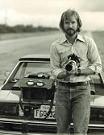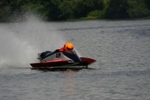John:
If you are assuming that the ignition assembly pictured was originaly furnished with the Harrison engine, I am almost sure that was not the case. Not absolutely positive, but 95% sure the ignition pictured did not make its appearance until after Kay and his father were past the Anzani/Harrison adventure. I may be wrong but I don't think so. Following is my information/knowledge about the ignition pictured.
At a race in Florida in the mid to late 70's I believe, one of the Small brothers was badly injured when a self excited ignition being furnished on the Konigs had the magnet portion of the flywheel disintegrate while the motor was being started and reved on the bank. The pieces struck him in the top of the shoulder, close to the neck area as I remember and severely injured him. The PRO commission at the time had an immediate meeting to address the issue and came up with a mandated guard around the rotating parts of the ignition so as to capture or attempt to contain any loose parts, if it happened again. To the best of my knowledge it never did, or at least I never heard of another occurance, but as a result of the accident several motor manufacturers/tuners came out with guards that could be retrofitted to the ignitions already in use. This IS NOT to say the ignition pictured never was used on an Anzani or the Harrison derivitive, only that it was not, I don't believe, designed for the motor to start with. The ignition components were manufactured by Phelan I believe, and I heard were originally used on a chain saw or other small engine and were not really designed to withstand the higher RPM duty of the Konig racing engine. I have at least two if these ignitions that were used on Yamato 80's in the RB class. Each ignition module or "porkchop" as it was called fired two coils on the Konig, one each for both the top and bottom cylinders and four coils were used. Only two porkchops were needed as the top two and bottom two cylinders on the Konig fire at the same time as I am sure you are aware.
Kay of course could be the final source of information on the ignition, but as I stated previously, I believe the first time these were used was after the accident in Florida. The ignition itself was quite satisfactory, although there were some of the "porkchops" that were supposedly better for higher RPM than others. I think they had a mark of some sort on them but I don't remember now what it was.
Your photos are great and I look forward to more on these engines.


 Thanks:
Thanks:  Likes:
Likes: 









Bookmarks